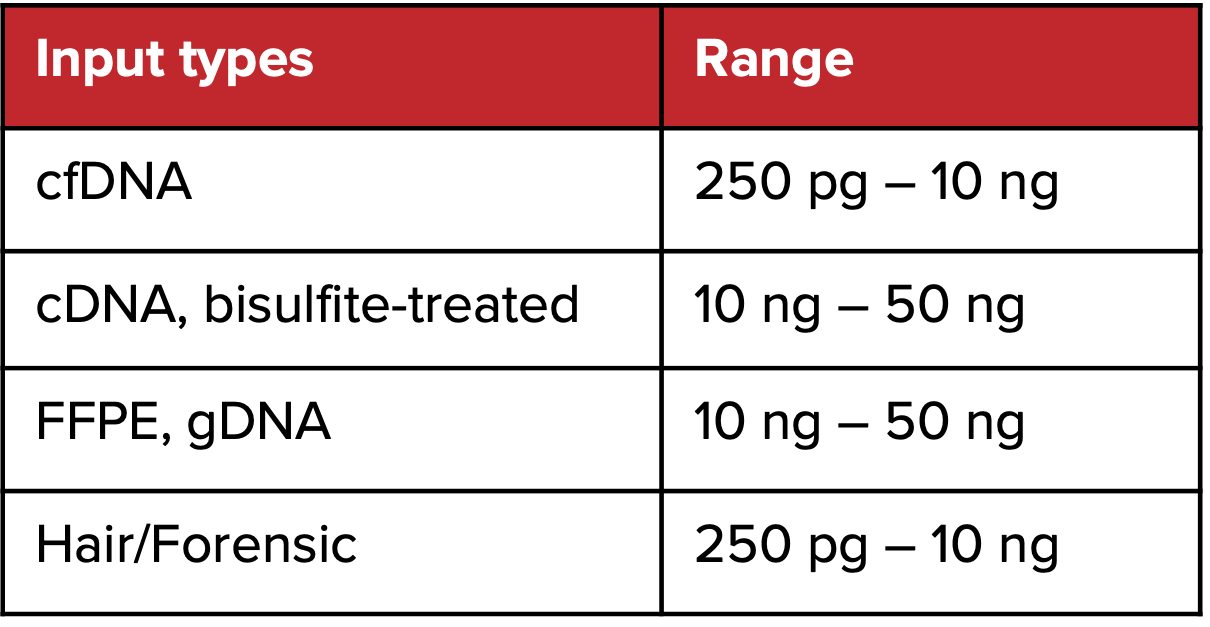SRSLY® for DNA
Get SERIOUS about your degraded DNA
SRSLY - our Single Reaction Single-stranded DNA Library Prep Kit. SRSLY is a simple and efficient ligation-based single-stranded DNA library preparation method that is engineered to produce complex libraries from samples with limited and/or degraded inputs. SRSLY recovers complete double-stranded DNA molecules, even when they contain nicks, plus single-stranded DNA molecules inaccessible to most NGS prep kits. Furthermore, the freedom of choice during DNA cleanup allows the user flexibility to decide whether they want to retain or discourage a substantial portion of short fragments. Did we mention it does all of this, from sample to sequencer, in under 3 hours without altering the native ends of cell-free DNA molecules? Seriously.
No matter your sample type, we got you - biologically degraded nucleic acid samples (cfDNA, forensic samples, ancient DNA), DNA sheared in vitro, synthetic oligonucleotides or probes, damage DNA (FFPE), and even first-strand cDNA.
Why SRSLY
SRSLY is versatile. It works well with a variety of inputs due to its unique molecular and informatic features. First off SRSLY renders all input molecules single-stranded before ligating novel splint adapters. This feature enables the direct sequencing of synthetic oligos and first strand cDNA products without the need for duplex hybridization or second strand synthesis. This feature also recovers template molecules containing DNA nicks and labile lesions, such as those that often afflict FFPE and ancient DNA (aDNA) samples. Secondly, SRSLY is a directional preparation method that retains both the native 5’ and 3’ ends of each template molecule by foregoing end-polishing. This feature improves fragmentomic analysis of cell-free DNA (cfDNA), where non-random DNA fragmentation reflects critical biological information. Finally, SRSLY allows the user the option to capture a substantial fraction of short DNA fragments because we understand that DNA templates come in all shapes and sizes. Consequently, the method is a powerful tool for difficult input types such as forensic and aDNA samples as well as for cfDNA researchers seeking to enrich for DNA derived from DNA binding proteins, mitochondrial and microbial DNA.
The unique molecular and informatic features of SRSLY that make it applicable to various types of input DNA
How SRSLY Works
SRSLY works in a one-step combined phosphorylation/ligation step that simultaneously prepares template DNA molecules for ligation without end-polishing and simultaneously ligates proprietary Illumina-compatible adapters.
Product Specifications
From DNA to sequence-ready Illumina® library in 2.5 hours
Options available for single and dual-indexing, as well as unique molecular identifier (UMI) incorporation
Single reaction and minimal reagents reduces failures due to error, reduces bench time
Additional protocols to retain fragments < 50 bp
How SRSLY Compares
cell-free DNA Case Study
Methods - Sequencing libraries were generated from two healthy cfDNA extracts. The results between SRSLY and 3 commercially available library preparation methods were compared.
SRSLY Libraries Produce High DNA Yields - allowing users more flexibility with downstream manipulations prior to sequencing
SRSLY Post Index PCR Yields and Mapping Statistics Compared to Commercial Kits
SRSLY Libraries Map with Accuracy and Retain More Short Fragments - Mapping performance of SRSLY is on par with the best commercial kits on the market. SRSLY goes above and beyond other kits by capturing a higher percentage of reads with short inserts (30-100 bp) to help researchers leverage valuable biology encoded in short cfDNA fragments.
SRSLY Libraries Produce Expected GC Coverage for cfDNA - cfDNA is known to have a higher fraction of GC rich sequences compared to gDNA.
SRSLY Generates Complex Libraries - Retaining native termini with SRSLY does not mean sacrificing library complexity. SRSLY ensures you get the most out of your 1 ng input by creating complex libraries on par with the best commercial kits on the market.
Biological Discovery, SRSLY
The majority of DNA fragments extracted from blood plasma cfDNA are centered around 167 base-pairs (bp) in length with a recognized sawtooth pattern of 10.4 bp that is the result of DNase I cleaving the exposed minor grove of nucleosome-bound DNA. In addition, cfDNA derived from blood plasma contains a valuable minority of short length sized DNA fragments (30-100 bp) that harbor footprints of transcription factors, other DNA binding proteins, mitochondrial DNA, and microbial derived DNA, all of which adds a valuable layer of detail to cfDNA sequence data.
SRSLY enables biological discovery by its ability to capture an increased proportion of sub-nucleosome sized fragments and by its ability to retain the native ends of DNA fragments. dsDNA preps, like NEB and TaKaRa, retain little data in the sub-nucleosome size range and end-polish terminal information away (above). The commercially available ssDNA method, available from Swift Biosciences, employs a molecular method which artificially shifts all data 10 bp shorter and abolishes the biologically relevant sawtooth pattern (left).
Want More SRSLY?
SRSLY Cell-Free DNA Brochure
SRSLY for aDNA & rootless hair Brochure
White Paper: Fragmentomics of cfDNA
Technical Note: SRSLY for RNASeq






